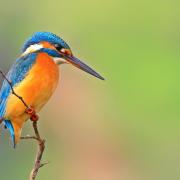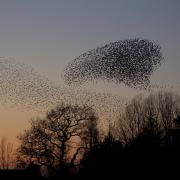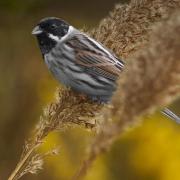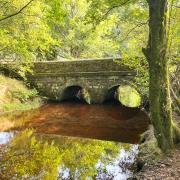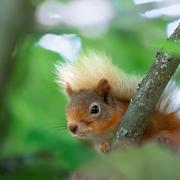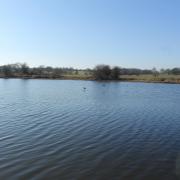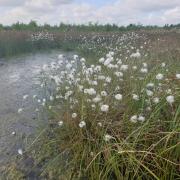Marine wildlife expert Dr Emily Baxter urges urgent action to set up conservation zones off the north west coast

The seascape of the North West may appear to be a blank vista, broken only by towering wind turbines and passing ships, but beneath the waves vast underwater landscapes stretch out across the Irish Sea.
Mountainous outcrops, seagrass meadows, kelp forests, sandy beaches and mud flats support a wealth of charismatic marine life – from basking sharks, the world’s second largest fish, to at least a dozen species of whale and dolphin, leatherback turtles, an abundance of grey seals and even the odd ‘circus’ puffin.
From cute to curious, how many of these Irish Sea species have you heard of? Oaten pipe hydroids and delicate sea pens, both relatives of anemones, corals and jellyfish; a clam called the ocean quahog, the world’s longest-lived animal (reaching over 500 years); the hedgehog sponge; the spiny squat lobster; the sea potato that’s actually an urchin; the sea mouse that’s actually a worm; and the ocean sunfish, the world’s largest bony fish, weighing in at a tonne!
Although we have a wealth of wildlife in our seas, decades of neglect have left them damaged and degraded, with habitats and marine life a shadow of their former diversity and abundance. There have already been notable changes in the numbers, distribution and size of some of our key species.

Basking sharks, common skate and cod have suffered from years of over exploitation from commercial fishing. Although now protected in UK waters, basking sharks are thought to have declined to just five per cent of historic levels. Skate were once common in British waters and formed an important staple food for coastal communities, but they were considered locally extinct in the Irish Sea in the 1970s. Historically, cod were also plentiful off our shores. Now the collapse of important whitefish stocks is a stark reality.
Sadly, the general condition of our marine environment is in decline. The rich habitats of the Irish Sea, and the vast array of marine life they support, are coming under increasing pressure from human activities such as offshore development, underwater noise, destructive fishing methods, plastic and litter, invasive species and climate change.
So what’s being done to protect it? The UK Government have committed to implementing an ecologically coherent network of Marine Protected Areas by 2016. In an ideal world, some activities need to be restricted to ensure protection in these areas, much like in nature reserves on land. There should also be enough protected areas to allow all animals to recover. Finally, these areas should be well managed so that damaging activities are restricted. They shouldn’t just be lines on maps.
Part of this network will be formed by new protected areas called Marine Conservation Zones which will eventually give us the network of protected areas needed to address the crisis.

Initially, 127 zones were proposed but just 27 were designated and only two were in the Irish Sea – the Fylde and the Cumbria Coast. The Wildlife Trusts continue to be frustrated at the lack of ambition shown by the Government. This year, 14 sites were dropped from consideration due to the apparent economic cost of protection.
Three zones recently dropped by the Government lie in the northern half of the Irish Sea and the main feature of these areas is mud! They may not sound attractive but they are thought to be as diverse as the Amazon rainforest, just less colourful. Mud is home to sea urchins, clams, worms and other creatures that play an important role in the ecosystem by turning over sediment, releasing nutrients and helping the process of carbon storage.
The problem is that the mud is also home to the Dublin Bay prawn or Nephrops (the breaded tails are more commonly known as scampi and the whole animal as langoustine). Since the decline of whitefish fisheries, Nephrops have become the largest and most valuable catch in the Irish Sea.
At the moment there is a massive gap in the network of protected areas in the Irish Sea, due to a lack of protection of offshore muddy habitats. The Government have argued that implementing zones could have a ‘significant impact on Northern Ireland’s fishing sector’.

Unfortunately, the Government decisions to date bhave been extremely short-sighted – progress has certainly been slow in achieving longer-term gains that will benefit both marine wildlife and fishing.
Much of the fishing for Nephrops in the Irish Sea is happening above sustainable levels. The closure of a few small areas to fishing could reduce the landings by just three per cent, but there could be great benefits to the environment and industry.
A reduction in fishing to sustainable levels would actually result in greater yields and profits for the fishing industry. Nephrops within protected areas would be allowed to grow bigger and spill over into surrounding fished areas. Bigger Nephrops are worth more. Moreover, protecting some areas of mud would allow our vibrant marine life and their habitat to recover.
Contrary to the Government’s reasoning, bottom trawling for species such as Dublin Bay prawns is damaging the economy by preventing the recovery of other commercial fish species. Large amounts of bycatch are taken, affecting populations of fish like whiting, haddock, cod and plaice. A recent study of plaice that survive in heavily trawled areas has even shown that they are thinner and less healthy as a result of the destruction of their habitats and food resources.
Irish Sea fish stocks are among the most heavily exploited in the UK; it is not just our marine environment that suffers as result. Although it might not seem obvious, the ‘visitor experience’ of recreational sea users is negatively affected by a reduction in their interaction with marine life (via angling and diving or bird, whale and dolphin watching) when intensive fisheries impact on the health of the wider ecosystem.
Even the general public, with no direct interaction with the marine environment, can be affected if they know that creatures such as whales and dolphins are not as abundant in our seas as they used to be.
Both internationally and nationally concerns over the state of our seas and oceans continue to be raised by academics, non-Governmental organisations, industry specialists, and some politicians. However, we also continue to see a lack of positive action and high-level decisions taken by nations, policy makers and governments to try and remedy the situation with any seriousness or speed.
The North West Wildlife Trusts are campaigning to secure a network of marine protected areas throughout the Irish Sea in order to safeguard wildlife for the future. It is vital the nationally important and vulnerable habitats and species are included any protection that is afforded to our marine environment. Continued intensive trawling will prevent the recovery of many species.
Supporting sustainable fisheries, instead of encouraging overfishing and habitat destruction, could benefit industry and increase the value of fisheries, as opposed to an environmental principal that comes at a price to the industry. Marine Protected Areas are a fundamental part of this. The Irish Sea is an extremely busy sea, generating ever increasing interest from industry and developers, so it is vital that we save a space for our marine life.
Emily Baxter is the Marine Conservation Officer for the North West Wildlife Trusts (Cumbria, Lancashire, Manchester & North Merseyside and Cheshire). She completed a BSc Honours in Marine Biology and Oceanography at the University of Plymouth in 2008 and moved to Ireland to take up a PhD at University College Cork on the ecology and socio-economic impacts of jellyfish in Irish waters. After finishing in 2011, Emily worked on a number of projects throughout Europe before moving back to the UK to work for the Wildlife Trusts in 2012. If you would like to find out more about the work of the North West Wildlife Trusts you can visit www.irishsea.org or follow @LivingSeasNW on Twitter and The Wildlife Trusts Living Seas – Irish Sea on Facebook.












